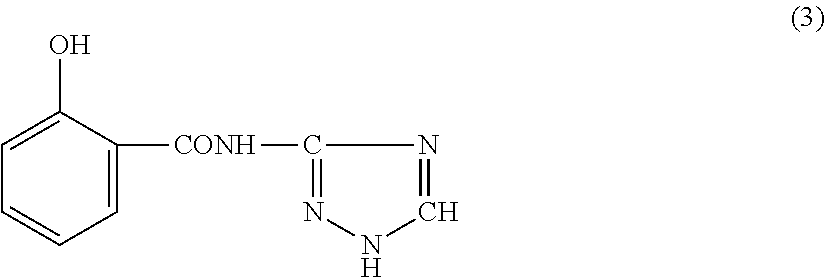Flame-retardant thermoplastic resin composition and molded article
a thermoplastic resin and flame retardant technology, applied in the direction of organic chemistry, organic chemistry, chemistry apparatus and processes, etc., can solve the problems of contact contamination, corrosive gas generation of flame retarders, corroding the screws of kneading machines or molds,
- Summary
- Abstract
- Description
- Claims
- Application Information
AI Technical Summary
Benefits of technology
Problems solved by technology
Method used
Image
Examples
examples
[0163]The effect of the invention is described more in detail below with reference to Examples. Here, “%” and “part(s)” always mean “wt %” and “part(s) by weight” respectively, and “ / ” included in resin names divides the components of copolymers. The characteristics measuring methods used are as described below.
[0164]The materials used are as follows.
[0165](A) Thermoplastic Resin
[0166] polybutylene terephthalate resin, Toraycon (registered trademark) 1401-X31 supplied by Toray Industries, Inc. The PBT used had an intrinsic viscosity of 0.80 (hereinafter referred to as PBT resin).
[0167] nylon 6 resin, Amilan (registered trademark) CM1010 supplied by Toray Industries, Inc. (hereinafter referred to as polyamide resin)
[0168] polybutylene terephthalate / polytetramethylene glycol copolymer, Hytrel (registered trademark) 5557 supplied by Du Pont-Toray Co., Ltd. (hereinafter referred to as Hytrel)[0169] polycarbonate resin, Panlite (registered trademark) L-1250Y supplied by Teijin Chemicals ...
examples 1 to 39
, Comparative Examples 1 to 13
[0222]A co-rotating, vent-equipped, twin screw extruder with a screw diameter of 30 mm and L / D ratio of 35 (TEX-30α supplied by The Japan Steel Works, Ltd.) was used. “(A) a thermoplastic resin”, “(B) a phosphinic acid salt”, “(C) a compound having a structure as represented by Formula (1) given above,” and other various additives as needed were mixed according to the compositions shown in Tables 1 to 6, and fed through the loading portion of the twin screw extruder. The glass fiber used as fibrous reinforcing material () was fed through a side feeder installed between the loading portion and the vent portion. Melting and mixing were carried out under extrusion conditions including a kneading temperature of 270° C. and a screw rotation rate of 150 rpm, and the melts were discharged into a strand, which was passed through a cooling bath and cut by a strand cutter into pellets. The resulting pellets were dried in a hot air drier at 110° C. for 6 hours, an...
PUM
| Property | Measurement | Unit |
|---|---|---|
| wt % | aaaaa | aaaaa |
| temperature | aaaaa | aaaaa |
| time | aaaaa | aaaaa |
Abstract
Description
Claims
Application Information
 Login to View More
Login to View More - R&D
- Intellectual Property
- Life Sciences
- Materials
- Tech Scout
- Unparalleled Data Quality
- Higher Quality Content
- 60% Fewer Hallucinations
Browse by: Latest US Patents, China's latest patents, Technical Efficacy Thesaurus, Application Domain, Technology Topic, Popular Technical Reports.
© 2025 PatSnap. All rights reserved.Legal|Privacy policy|Modern Slavery Act Transparency Statement|Sitemap|About US| Contact US: help@patsnap.com



